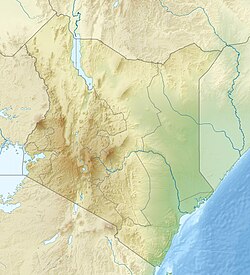Lothagam North Pillar Site
 Lothagam North Pillar Site in Turkana, Kenya | |
| Alternative name | Lothagam North |
|---|---|
| Location | Lake Turkana, Kenya |
| Coordinates | 3°25′22″N 35°48′10″E / 3.422778°N 35.802778°ECoordinates: 3°25′22″N 35°48′10″E / 3.422778°N 35.802778°E |
| History of Kenya |
|---|
 |
|
|
The Lothagam North Pillar Site, registered as GeJi9, is an archaeological site on the west side of Lake Turkana in Kenya dating to the Pastoral Neolithic. It is a communal cemetery, built between 3000 BCE and 2300 BCE by the region's earliest herders.[1][2][3] It is thought to be eastern Africa's largest and earliest monumental cemetery.[4]
The main burial mound is flanked by megaliths, stone circles, and cairns and is believed to hold the remains of hundreds of individuals.[3] Many of the people buried at Lothagam North were adorned with stone beads, ivory, animal teeth, rings or other ornaments.[2]
Background[]
The site is the oldest of six known pillar sites in the area and was in use for almost five hundred years.[4]
It is hypothesized that towards the end of African humid period, nomadic peoples would return to the site to bury their dead.[3][5] The changing climate caused the lake to recede revealing fertile land for herbivores to feed on.[4] The use of the site ended with the end of the humid period. The change in the climate may have forced the local inhabitants to move elsewhere.[3]
Recent research published in the Journal of Anthropological Archaeology has argued that the cemetery was for all members of this community, not just the leaders.[6][7] Each person was buried in a central mortuary cavity approximately 3 feet (0.91 m) deep. At the bottom of the mortuary cavity, pits with additional burials were carved into soft sandstone bedrock. Many burials were covered by sandstone slabs brought in from elsewhere.[3]
The cemetery was a planned, multi-generational project.[8]
See also[]
References[]
- ^ Hildebrand, Elisabeth; et al. (2018). "A monumental cemetery built by eastern Africa's first herders near Lake Turkana, Kenya". PNAS. 115 (36): 8942–8947. doi:10.1073/pnas.1721975115. PMC 6130363. PMID 30127016.
- ^ a b Dvorsky, George (20 August 2018). "Ancient Cemetery Packed With Hundreds of Bodies Discovered in Kenya".
- ^ a b c d e Maya Wei-Haas (20 August 2018). "Ancient Riches Discovered at Mysterious Burial Monument". National Geographic.
- ^ a b c Specktor, Brandon (22 August 2018). "Massive, Ancient Stone Monument in Kenya Held More Than 500 Bodies, 400 Gerbil Teeth". Live Science.
- ^ Kaplan, Sarah. "This ancient burial ground tells a story of unity in a time of climate chaos". Washington Post.
- ^ Sawchuk, Elizabeth A.; Goldstein, Steven T.; Grillo, Katherine M.; Hildebrand, Elisabeth A. (1 September 2018). "Cemeteries on a moving frontier: Mortuary practices and the spread of pastoralism from the Sahara into eastern Africa". Journal of Anthropological Archaeology. 51: 187–205. doi:10.1016/j.jaa.2018.08.001. ISSN 0278-4165.
- ^ Cara Giaimo (21 August 2018). "Lessons From a 5,000-Year-Old Kenyan Cemetery". Atlas Obscura.
- ^ Jason Daley (22 August 2018). "Their World Was Crumbling But These Ancient People Built a Lasting Memorial". Smithsonian Magazine.
External links[]
- Josh Gabbatiss (20 August 2018). "Massive ancient cemetery built by early herders unearthed in Kenya". The Independent.
- Archaeological sites in Kenya
- Lake Turkana
- Cemeteries in Kenya
